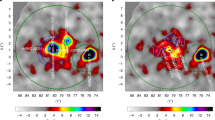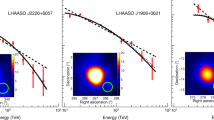Abstract
The discovery of an extraordinary new X-ray source detected during a guest observer programme carried out with the Einstein X-ray Observatory is reported here. The object, designated G109.1–1.0, was found using the imaging proportional counter detector (IPC) on 17 December 1979. The IPC is sensitive to X-ray photons with energies between 0.1 and 4.5 keV. A longer exposure (3.6×103 s) IPC picture of a 1° field of view centred on the SNR was obtained on 8 July 1980 and is shown in Fig. 1. The picture shows a clear semicircular arc with an angular diameter of 36 arc min which appears to be the outer shell of the SNR. The resolution of the picture is 1 arc min. At the exact centre of the curvature of the shell is a strong compact source which we designate GF2259+586. The X-ray coordinates of GF2259+586 are RA=22 h 59 min 02.5 s and dec = 58° 36′ 38″. The 1 arc min accuracy of the coordinates is limited by systematic calibration errors in the IPC detector. Emerging from the east side of the central source is a jet-like structure which curves northwards in another continuous arc smoothly joining the outer shell. On closer inspection, the jet appears to bifurcate with a second component continuing radially outwards from the central compact source. This very unusual structure has parallels with the W50 SNR with its central X-ray source SS433 and jet (F. D. Seward, personal communication).
This is a preview of subscription content, access via your institution
Access options
Subscribe to this journal
Receive 51 print issues and online access
$199.00 per year
only $3.90 per issue
Buy this article
- Purchase on Springer Link
- Instant access to full article PDF
Prices may be subject to local taxes which are calculated during checkout
Similar content being viewed by others
References
Sharpless, S. Astrophys. J. Suppl. 41, 257–279 (1959).
Wilson, R. W. & Bolton, J. G. Publ. astr. soc. Pacif. 72, 331 (1960).
RaghavaRoa, R., Medd, W. J., Higgs, L. A. & Broten, N. W. Mon. Not. R. astr. Soc. 129, 159–168 (1965).
Clark, D. H. & Caswell, J. L. Mon. Not. R. astr. Soc. 174, 267–305 (1976).
Crampton, D., Georgelin, Y. M. & Georgelin, Y. P. Astr. Astrophys. 66, 1 (1978).
Gorenstein, P. & Tucker, W. H. A. Rev. Astr. Astrophys. 14, 373–416 (1976).
Ryter, C., Cesarsky, C. J. & Audouze, J. Astrophys. J. 198, 103 (1975).
Author information
Authors and Affiliations
Rights and permissions
About this article
Cite this article
Gregory, P., Fahlman, G. An extraordinary new celestial X-ray source. Nature 287, 805–806 (1980). https://doi.org/10.1038/287805a0
Received:
Accepted:
Issue Date:
DOI: https://doi.org/10.1038/287805a0
This article is cited by
-
Radio emission from AXP and XDINS
Astrophysics and Space Science (2007)
-
Observation of stellar remnants from recent Supernovae
Nature (1984)
Comments
By submitting a comment you agree to abide by our Terms and Community Guidelines. If you find something abusive or that does not comply with our terms or guidelines please flag it as inappropriate.



